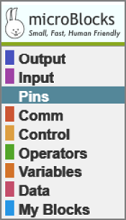¶ Pins
¶ read digital pin

Returns the value of the digital pin specified on the micro device as either true or false. A pullup true/false setting can be access by clicking the white triangle at the right end. Pullup setting forces the signal high in case of fluctuating voltages on the pin.
Digital pin 0 is read continuously and the results displayed and graphed. Pullup is enabled, meaning the normal status of the line is High.
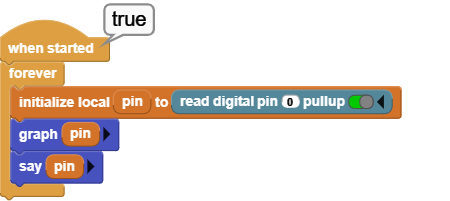
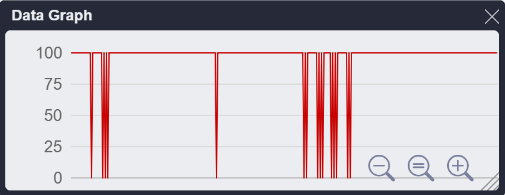
¶
read analog pin

Returns the value of the analog pin specified on the micro device as a number in range 0-1023. A pullup true/false setting can be access by clicking the white triangle at the right end. Pullup setting forces the signal high in case of fluctuating voltages on the pin.
Analog pin 0 is read continously and the results displayed and graphed. Pin 0 is not connected to anything during the test. Pullup is NOT enabled, meaning the signal status of the line is fluctuating constantly, as can be seen in the graph.
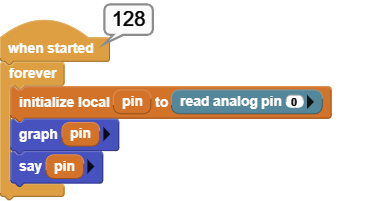
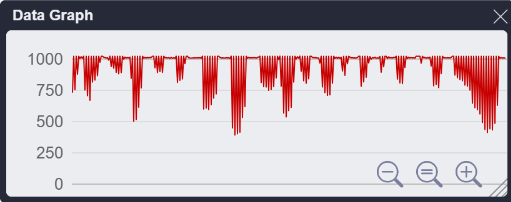
¶
set digital pin

Sets the state of the digital pin specified as either true or false. On a 3.3V device, a high setting will put 3.3V, and a low setting will put 0V on the pin.
Two loops are coded. Left one toggles pin 0 three times between high and low settings. Since reading he pin status, while it is being changed, might affect its state, pin 0 is connected to pin 2 with a simple cable. In the right loop, pin 2 is read (should reflect the same values as pin 0) and graphed. The graph shows pin 0 toggling three times.
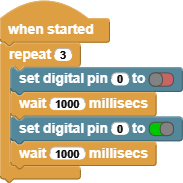
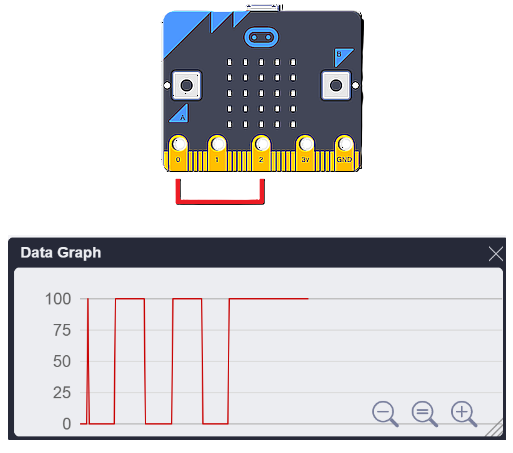
¶
set pin (analog)

Generates a pulse width modulation (PWM) signal on the given pin that approximates a power level from 0-1023. PWM works by turning the pin on and off rapidly. The power is controlled by varying the duty cycle: the percent of the time during each cycle that the pin is on. A value of 0 means the pin is off, while a value 1023 means full power (i.e. the pin is on 100% of the time). A value of 512 results in a 50% duty cycle; the pin is on half the time and off half of the time. PWM can be used to control the brightness of an LED or the speed of a motor.
Some boards have one or two pins equipped with digital to analog converters (DACs). When this block is used with such pins, the pin outputs a steady voltage instead of a PWM signal. A value of zero means 0 volts, a value of 1023 means the full power supply voltage (3.3v or 5 volts), and 512 is half of the full voltage.
Program reads analog pin 2 in a continuous loop, and sets the analog pin 0 to the value read. This is a typical example of a motor controlled by a potentiometer, as shown in the picture.
Note: This simulation is simplified for the sake of clarity. Real motors require more power than the output pin of a microcontroller can supply. Thus, in practical motor applications the PWM signal from the microcontroller is connected to a transistor or motor control chip that drives the motor.
For video of the running example, see the video tab.
 |
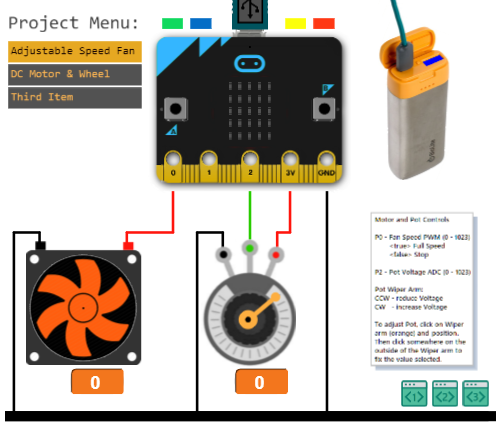 |
|---|
¶
analog pins

Returns the number of analog pins present in the connected micro device.
Program displays the attached device's type and the type and number of pins it supports.

¶
digital pins

Returns the number of digital pins present in the connected micro device.
See analog pins example above.
